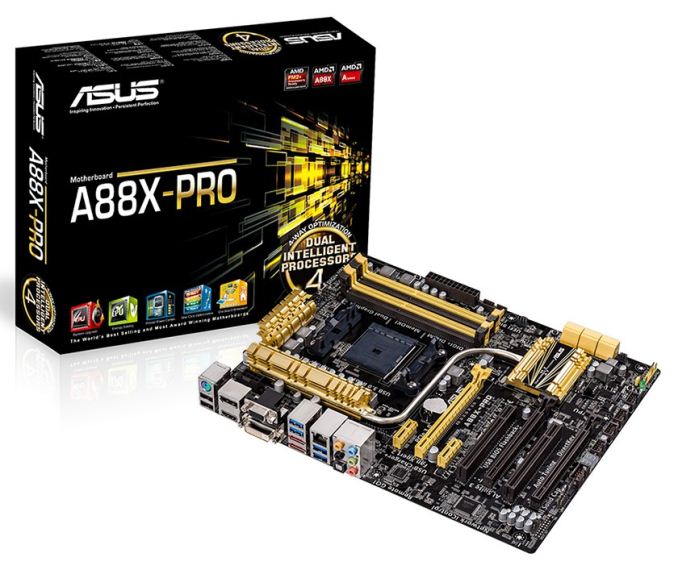ASUS A88X-Pro Review: Kaveri, Kaveri, Quite Contrary
by Ian Cutress on April 22, 2014 11:59 AM EST- Posted in
- Motherboards
- AMD
- Asus
- Kaveri
ASUS A88X-Pro Conclusion
High-end motherboards of any platform should come under strict scrutiny. The problem arises when one platform’s ‘high-end’ is the mainstream’s ‘lower-mid-range’. What is a premium on this cheaper platform is par for the course on the mainstream, which is an issue that can cloud judgment.
The ASUS A88X-Pro sits atop of the FM2+ stack with a variety of added features, especially over the $68 A88XM-E35 we reviewed previously. For almost double the cost, the ASUS A88X-Pro gives a larger overclock, more memory space, a better audio codec, more USB 3.0 ports, more SATA ports, support for Crossfire, intelligent processors to manage power consumption and a strong software platform. At the end of the day it performs slightly better at stock as well.
I have seen users in the comments of previous reviews on AnandTech comment along the following lines:
“If it costs 10% more but does not give +10% performance, what is the point?”
The A88X-Pro is never going to give +82% performance over the A88XM-E35. While the A88X-Pro offers +100% in DRAM slots and power delivery VRMs, it gives only +33% in USB 3.0 ports, +0% in network ports, an unknown percent in audio codec improvement and ~+30% in motherboard area. If we look at IO performance, asking for +82% seems silly. You cannot even put a percentage in terms of software and BIOS differences.
The flaw here is expecting linear gain for linear cost increase. To start there is a fixed base cost in the motherboard industry (chipset and PCB), then we must consider that moving up the stack in terms of feature set which increases both complexity and R&D cost. You are going to be up against the law of diminishing returns very early on. When deciding how much of a budget should be put towards a build, the motherboard segment often comes lower down the list (CPU, GPU and SSD might come first) unless you need specific functionality. But the market for high-end models still exists, and the A88X-Pro comes across as highly recommended in this range.
A side note: we are looking into the restarting flaw that seems to occur during our specialised benchmark under high CPU load. Signs may point towards early batch of Kaveri processors that draw higher current, or the silicon lottery. We need to get a newer one in to retest our Photoscan benchmark.












34 Comments
View All Comments
Antronman - Tuesday, April 22, 2014 - link
It's Asus.Of course it's going to be recommended.
Every fool knows Asus is #1
yannigr - Tuesday, April 22, 2014 - link
And those who are not fools? What do they think about ASUS? :PHanzNFranzen - Wednesday, April 23, 2014 - link
lol!! =)Yorgos - Tuesday, April 22, 2014 - link
I am really happy with asrock extreme6+, which packs more features+1 64 Mbit Flash ROM (awesome feature)
+1 HDMI (4 monitors in total)
-1 eSata (instead of 2 on the asus)
-2 usb2.0
+1 Sata
+ power and reset buttons (f* great feature)
+ doesn't make you look like a pimp with gold teeth
+Wake on LAN
+ cheaper for around 20 € in my country than the asus
In my opinion you CANNOT beat those feature with a better price and better benchmarks.
That's why I never read the conclusions, If I wanted an opinion I could ask also my dog, both of them have the same value.
Alexvrb - Tuesday, April 22, 2014 - link
What about PWM (4-pin) fan headers? If I was in the market for this kind of board, this A88X Pro would be the one I'd get, just because of its abundance of 4-pin connectors (5 of them). Most ATX A88X boards have... 3? With maybe one or two 3-pins to go with them. Yeah, you can get splitters (better get well-made ones) but then you can only monitor the speed of one of the connected fans per motherboard header.Antronman - Wednesday, April 23, 2014 - link
Yeah.And it's ASUS quality.
Alexvrb - Wednesday, April 23, 2014 - link
Which, most of the time, means it's good. I've been burned over the years by most of the major manufacturers at least once, including Asus. Sometimes it's a hardware/design issue, sometimes it's software/firmware. On occasion it was a problem with the chipset itself, and not entirely the manufacturers fault. About the most solid boards I used were by Epox, hilariously enough.But yes, overall I'd consider Asus to generally produce good boards, particularly if you're buying one of their "premium" models.
tuklap - Friday, April 25, 2014 - link
I just hope Asrock placed anti surge ic's and esd protections :(just4U - Tuesday, April 22, 2014 - link
In my opinion none of this matters until they finally release the A8- 7X series processors. Don't know about the rest of you but I've been eyeing it for multiple builds simply because of it's price/performance ratio. I'd expected it to be release already.HiTechObsessed - Tuesday, April 22, 2014 - link
My problem with these APUs is something like the A10-7850k costs $180, or you can get the 750k for $80, and a 7770 GHz for $100 and blow the 7850k out of the water in performance. APUs don't make sense on large boards like this when you can pair the same CPU up with a dedicated GPU and get much more gaming power.